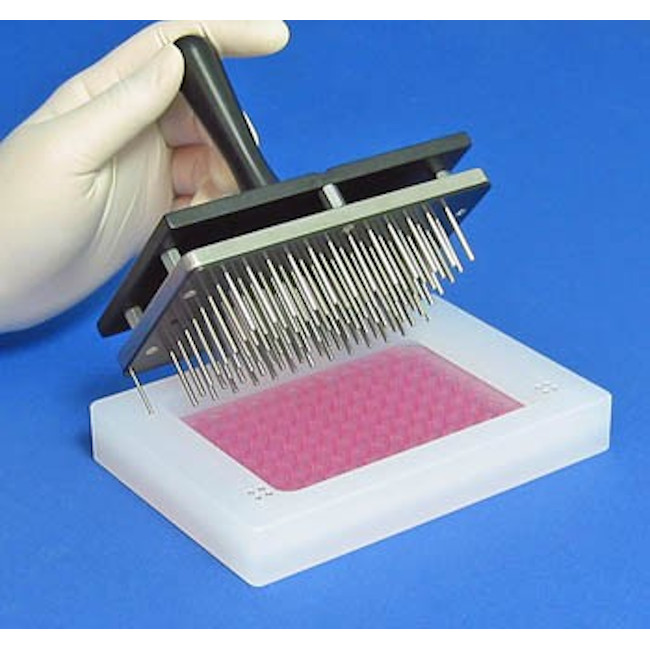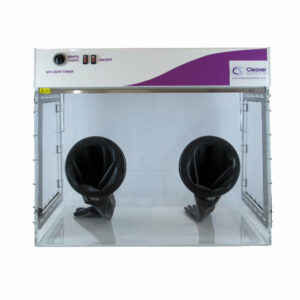The VP 407FP12 is designed to be used by hand. It comes complete with a BMPM and 96 FP12 pins. The 2.36 mm diameter stainless steel FP12 pins have flat tips. As the Replicator is lowered onto the gridding surface, each pin rests on a single float plate assembly until it touches on the gridding surface and delivers ~1.5 ul of liquid in the hanging droplet at the tip. When the tip hits the surface the pin floats up through the holes. This floating action assures that each of the pins will deliver its droplet even if the blotting/gridding surface is not level or smooth.
Manual Pin Replicators are available in 2 basic styles:
- Replicators with Pins that are fixed into position by pressing them into an aluminum Replicator plate.
- Replicators with Pins that “float” between two aluminum Replicator registration frames with holes in them.
.
The fixed pin Manual Replicators vary in diameter from 0.457 mm to 6.35 mm and in length from 22 mm to 57 mm.
The floating pin Manual Replicators vary in diameter from 0.229 mm to 4.77 mm and in length from 12 mm to 41.5 mm.
All of our Manual Replicators have 2 guide pins outside the array that are used to register the Manual Replicators to the microplates by placing the guide pins into alignment holes drilled into a Library or a Colony Copier registration device, see the photo below.

The type of floating pins used in Manual Pin Replicators fall into two categories,
- Tube Pins are stainless steel pins that are fixed inside tubes (cannulas) to provide greater strength to fragile small diameter pins. These tubes rest upon the lower of two thin float plates separated by a standoff.
- E-Clip style of stainless steel pin have larger diameters which are grooved to accept an E-Clip which rests on a single thick float plate.
The Floating Tube pins vary in diameter from 0.229 mm to 0.914 mm, they also vary in the total length of the pin (from 33 to 62.2 mm) and the length of the exposed pin (from 12 to 17 to 30 to 41.5 mm) long. The exposed length terminology is used to define how far the pin is able to extend below the bottom float plate.
The volume of liquid transferred on a pin will vary with the diameter of the pin, the depth to which it is submerged into a liquid, and the speed the pin is withdrawn from the liquid. Also the surface tension of both the pin and the liquid will affect the volume transferred.
Both the Tube and E-Clip pins can be modified by cutting a very small precise slot in the tip of the pin which fills and drains by capillary action. The advantage of the slot pin is that if there are different volumes in the source wells (if the plate has been cherry picked many times) the slot pin will be less affected by the different volumes in the source plate. A slot pin, because of filling by capillary action from the bottom of the pin is able to make transfers from very small liquid volumes in source plates. Slot pins also yield a greater precision. The volume in the slot of a tube pin varies from 6 nl to 2,000 nl.
The E-clip pins range in diameter from 1.58 mm to 4.75 mm and from 22 mm exposed length to 49 mm exposed length. The E-clip pins can also be slotted and the slot volume ranges from 0.5 ul to 5 ul.
Both the Tube style pins and the E-clip pins can be coated with a hydrophobic layer to reduce non-specific binding to the pin.
We have sold over 50,000 Multi-Blot Manual Pin Replicators over the last 34 years and these versatile instruments have been used in many different applications from replicating genomic libraries, screening drugs for activity to making arrays on membranes and agar surfaces. The following links will take you pages on our old web site that list in great detail all the applications we are aware of or our customers have reported to us. In addition we have links to journal articles that describe many of these applications at this page.
- # Liquid to Liquid Transfers
- .
- # Liquid to Dry Surface Transfers
- .
- # Liquid to Membrane Transfers
- .
- # Making High Density Arrays
- .
- # Inoculation with Replicators
- .
- # Picking Colonies from Agar Plates
- .
- # Washing Pin Tools and Tips
- .
- # Frozen Specimen Sampler
- .
- # Madge Gel Loading
- .
- # Store DNA on Clonesaver 96 Card
Gifs



